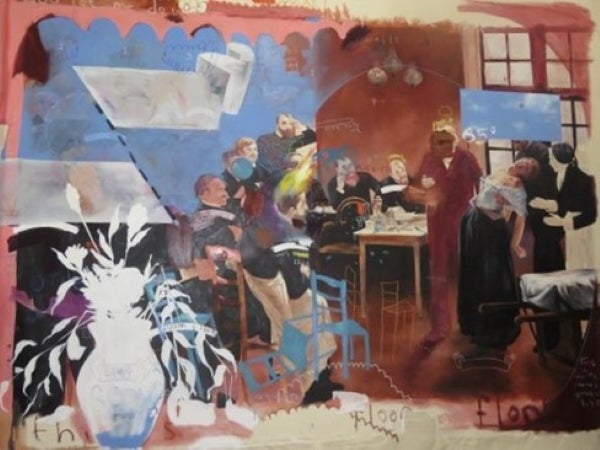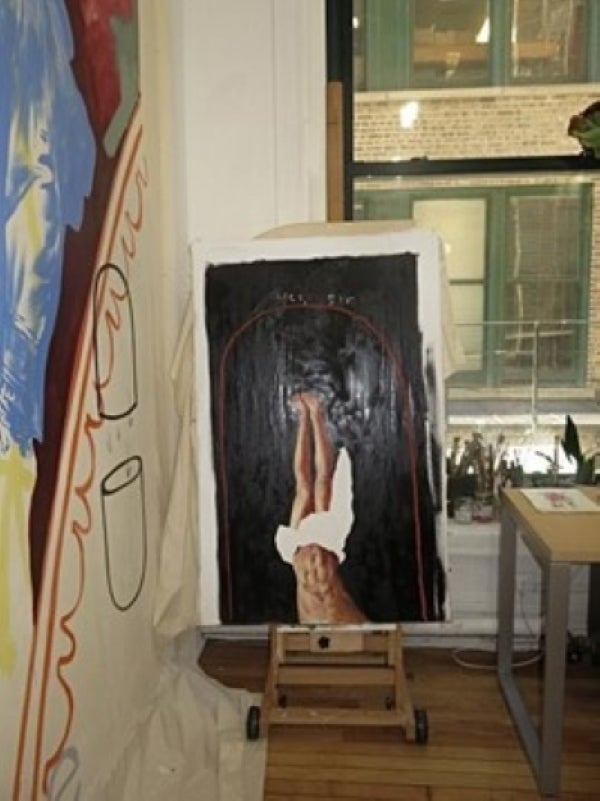Reimagining Madness: The Art of Matt Bodett
x

In the world of art, many artists strive to answer questions regarding the unknown, wanting to shed light on and explain the complexities of life. Matt Bodett, however, strives to leave his audience with even more questions than they arrived with through his explorations of mental health, “madness” and the harmful effects of European historical and cultural narratives in his art.
Living with schizoaffective disorder, Bodett employs his own experiences and art historical references to examine and identify these themes, creating compelling artworks that call audiences into a complicated and sometimes unsettling dialogue. His gallery on display at the Center for Mad Culture, was promoted by the UIC Disability Cultural Center (DCC) in July as part of Chicago Disability Pride Month, highlights the importance of such art in fostering dialogue and awareness about mental health.
“In all of my paintings, I definitely start from an art historical reference,” Bodett shared, laying out the basis of his work. “Most of my work deals specifically with madness and my relationship with it. I was diagnosed with schizophrenia, [a diagnosis] deeply rooted in European psychiatry and psychology, handed to us through art history. There’s a big convergence of thought that occurs through art, and then the philosophies get turned into psychology and psychiatry.”
One of the prominent gallery pieces is inspired by a French painting from the 19th century called “Clinical Lesson at La Salpêtrière,” which depicts a professor teaching aspiring doctors about hysteria in a mental asylum. Bodett reimagines this historical work, overlaying it with his own viewpoints and experiences to show how these kinds of stories have influenced how we think about mental health.
“My work is an intuitive process on top of these historical references,” Bodett said. “I call upon my own experiences to show how damaging that type of history can be, even in my own diagnosis and what I’ve been through in my lifetime.”
x

Having grown up in a conservative religious environment also plays an essential role in Bodett’s understanding of mental health and how he tackles it in his work. The fluid and dynamic nature of his creative process reflects Bodett’s conviction that nothing is ever really done. His paintings’ deliberate use of incompleteness and negative space is indicative of this.
“I don’t like the idea of finality. Nothing should ever be completely finished,” Bodett asserted. “It comes back to how history was presented to us—everything is final, set in a frame. But we’re all different people, and we’re allowed to change. Having things incomplete offers the potential for open-ended conversations.”
In addition to reflecting the disorder and fragmentation of living in a state of madness, Bodett’s art tries to start a meaningful conversation with viewers about mental health and how society views insanity. It is his aim that the experience of viewers would be one of wonder and disorientation, reflecting the artist’s own journey.
“People often comment on how chaotic my work is and how it makes their brains feel all over the place. That’s exactly what I want—it should confront you from all these different aspects because that’s what living with madness is like,” Bodett explained. “In that confusion, we can have a more honest conversation about mental health.”
Bodett asks viewers to reevaluate what they think to be madness and to question the cultural lessons that have influenced these views through his artwork. Through posing questions to viewers about their own biases, he seeks to promote greater comprehension and compassion for people who live with mental illness.
“My work challenges us to think about what we see as madness and why we call it that,” Bodett said. “Why do we revere saints who lived in caves and talked to birds, but ignore or fear people on the streets who are labeled as crazy? Our culture teaches us to feel unsafe around them, but that’s a cultural construct, not a reality.”
Ultimately, Bodett wants his work to provoke viewers to consider their own prejudices and preconceived notions about mental health and societal standards, leaving them with more questions than answers.
“I hope people don’t know what to take away from my work,” he concluded. “I want them to be challenged and confronted by their own minds, recognizing their prejudices and assumptions. In that space of uncertainty, we can begin to have more honest and meaningful conversations about mental health.”
In addition to producing visually stunning works, Matt Bodett challenges the historical myths that have long shaped our ideas of mental health and promotes a deeper, more nuanced understanding of “madness” using his powerful and provocative art.